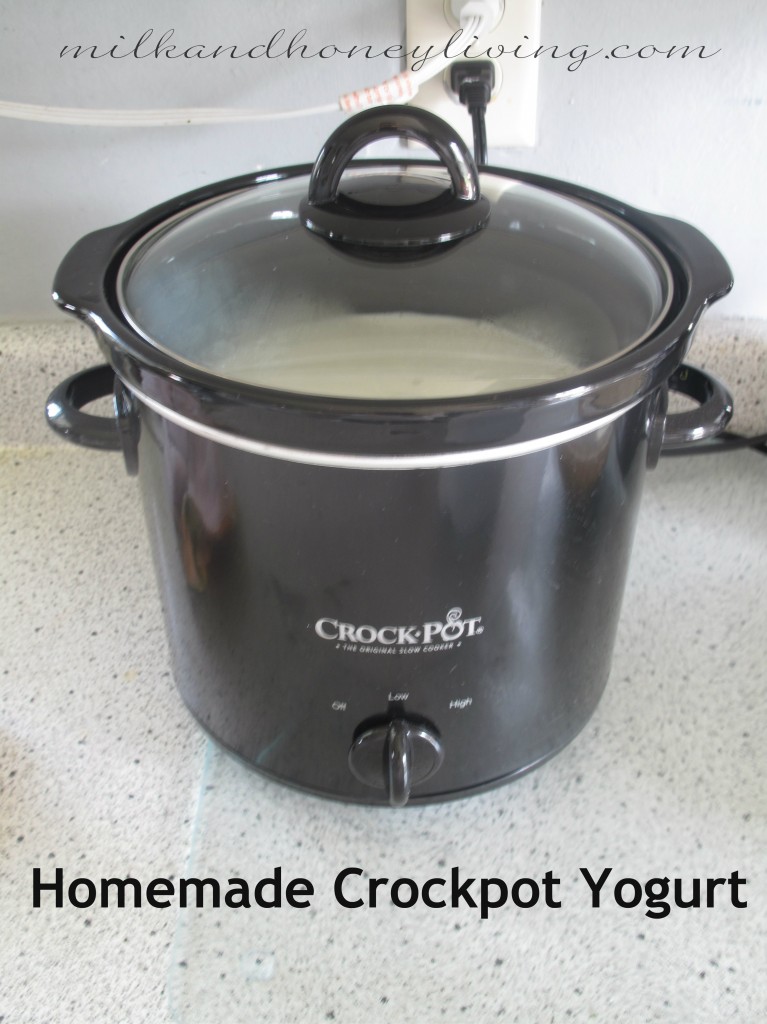After learning more about the incredible benefits of traditional food fermentation and especially the benefits of the healthy probiotics found in yogurt, I am totally convinced that yogurt is an absolute must in my kitchen for the health of my family. I am NOT talking about dyed, naturally or artificially sweetened and flavored yogurt; I am talking about the organic, whole milk, unsweetened, plain kind! Once you have plain yogurt, there are ways to naturally sweeten it (and control the amount) by using raw honey, maple syrup, agave nectar, berries, or fruit puree, etc. If this isn’t the most gorgeous and tasty afternoon snack, I don’t know what is! Throw on some Homemade Granola or a few raw almonds and you’re set!
This might seem ridiculous, but let me give you a little yogurt expense breakdown:
Annual Yogurt Expense
It is probably fairly typical for many growing families to spend money on yogurt each week; it is probably less typical to think about how much one actually spends on an individual grocery item over the course of a year. Well, the local grocery store that I had previously been purchasing our organic whole milk plain yogurt has now gone up in price to an INSANE $5.19/quart. WHAT?! I will say, I searched around and found it for $3.39/quart at another local store, but depending on where I am planning to shop when we need it means I might spend anywhere from $3.39 and about $4.50 (I REFUSE to spend $5.19). Either way, our annual yogurt cost COULD be up to $234. Yes, that is almost $250 a year JUST on yogurt!
With that said, for the last few months I have been making our yogurt. There are a variety of reasons it has become a priority, but the far and away number one reason is the budget.
Annual Homemade Yogurt Savings
After figuring out how much I could be spending, I wanted to see how much I was saving. I currently make 2 quarts for $3.50 or less (that is $1.75/quart). That means, assuming we eat 1 quart/week, I could be spending anywhere between $176-$234/year! Instead, making it costs us $91/year; however, I’ll round up to $100 because I buy a new yogurt starter after every few batches and we might use more than one quart in a week.
Regardless, roughly 10 minutes of my time every two weeks saves anywhere from $76-134/year. To take it one step further, breaking that down into an “hourly wage” means I “make” (or simply don’t spend) roughly $33/hour of invested effort.
Every time I mention that I make yogurt, people are a little shocked, a bit confused (“you can do that?”), but definitely curious! I know it sounds a little creepy, as one is essentially growing (good) bacteria in her kitchen, but it is so easy! And I started realizing, “wait, I trust huge corporations to produce my food, yet won’t trust myself and “traditional” methods?” So, I gave it a shot and love it! We eat a boatload of yogurt each week; as mentioned above, it is a great snack (with berries, nuts or homemade granola), it is a delicious & healthy base for creamy smoothies, and it is perfect for some of my baking. Plus, this homemade recipe tastes just as good, if not better, than its store bought counterpart.
So, do you want to know how?
While researching, I came across a wide variety of yogurt recipes and ways to make it, but ultimately this Crockpot Yogurt seemed the easiest and most fool-proof!
Homemade Crockpot Yogurt
In a 4 quart crockpot, pour in 1/2 gallon (8 cups) of milk
Turn crockpot on LOW and heat for 2 hours & 45 minutes
After time has elapsed, turn off the crockpot and let the milk cool in the crock with the lid on for 3 hours.
After the additional time has elapsed, remove lid and stir in 1/2 cup of yogurt with live active cultures and mix very well (I whisk while I pour and then for an additional 30 seconds or so).
Place the cover back on the crock and wrap the entire crock pot in a thick bath towel or two.
Let culture overnight, 8-12 hours.
In the morning stir yogurt and transfer it to glass quart jars or a container of your choice.
Refrigerate for at least 8 hours before using.
(Recipe adapted from Nourising Days)
Personal Notes (directions and ingredients):
I use Organic Valley Whole Milk and Stoneyfield Farms Organic Whole Milk Plain Yogurt as my starter yogurt (i.e. the 1/2 cup that is whisked into the heated milk). On “yogurt making day” I always start the yogurt at 2:30pm because that allows me to turn off the heat at 5:15 (when we’re usually in the kitchen for dinner anyway) and then add the starter at 8:15pm. That way, I know that I will be up and home the next morning between the 8-12 hour culture time in order to transfer it to other storage containers and pop it in the fridge. The whole process truly doesn’t take any more than 10 minutes and it has yielded ideal yogurt every time.
I’d love to hear if you give it a shot or have any questions!
Becca V
Latest posts by Becca V (see all)
- My New Favorite Carseat - September 16, 2016
- Quick Lit: April 2015 - April 15, 2015
- How’s It Going? - February 24, 2015








Thank you Becca! You made this sound so easy (love the timed guide) and I’m going to do it! We eat a ton of yogurt too.
oh, wonderful! let me know how it turns out :)
THIS IS AWESOME! I am RT’ing this right now!
[…] items (like Homemade Yogurt, Granola, Graham Crackers, Almond Butter, Pizza Dough, etc.) are simple to make, often healthier […]
Here goes! It’s in the crock right now. I hope it’s as easy as it seems! I’ll let you know tomorrow!
[…] Homemade Crockpot Yogurt […]
Sounds easy… Do you know if this process will work to make Greek yogurt too? Thanks :)
yes, it is super easy and does work to make Greek yogurt too (which is essentially just regular yogurt strained to become thicker). Make yogurt per the directions and then line a fine mesh strainer with cheese cloth and strain the yogurt, this will result in the whey pouring off and the yogurt getting thicker. But you can save the whey to add into smoothies for additional nutritional boost!
Can you use a larger crockpot and double the recipe?
You could probably use a larger crockpot; however, I am not sure how the temperature, starter percentage, etc. would differ in a larger amount and therefore certainly don’t want to confirm that would be ok or turn out the same. So, I personally would stick to one batch at a time with this recipe.
I have a 5 qt oval crockpot – do you think it will work with either the same amount of ingredients or 1 1/2 the ingredients? Next question, where do you buy your yogurt you use as the starter? I am very excited about my husband finding this. I have been looking at yogurt makers but this would be even better. Third, I thought greek yogurt was just left longer vs. being strained. Thank you so much for your post.
1.) I believe the larger crock pot would work fine, however, I don’t recommend changing the recipe, because I am not sure of the measurements yielding the same result. Some people have said that using a different size pot can make the yogurt a little more “bouncy”- not sure?! 2.) I usually buy Stoneyfield Organic Whole Milk yogurt for my starter, which is pretty much sold everywhere now and I’ve found the best prices at target or on sale at local health food stores. 3.)Technically, I believe the difference is that traditionally Greek yogurt is made with sheep’s or goats milk (not cow’s) and also a combination of cream and milk yielding a higher fat content, etc. and then an additional straining process. I’m not sure of a time difference with temp/heat? Interesting! Thanks for reading :)
Hi, How long does it last in the fridge? Does it freeze? Can you use the yogurt you made to make more yogurt? This looks awesome. We eat a ton of yogurt.
1.) I’d say it lasts 4 weeks in the fridge (I like to think about the dates on yogurt cartons from the store, they last a pretty long time!!), but we usually go through a batch in about two. 2.) Plus, if you won’t eat it that quickly, yes you can certainly freeze and thaw it, but give it a good stir, the consistency may be a little different. 3.) YES, you can use this as the starter for your next batch, but it will gradually get thinner and less potent, so I would buy a new starter every couple months!
I want to try this today. Will this still work in a 6 qt crock pot?
Sorry I just read the above comments and my question was already asked and answered! Thanks!
No problem! I hope you gave it a shot and it turned out great!
I did! It’s perfect for smoothies! I’m trying to make a lower fat version with vanilla today!
glad to hear!
This is very interesting, thanks for the tips. Just wanted to lend beginner yogurt makers another small tip. You can culture your yogurt for 24 hrs to yield a yogurt that all of the sugars have been cooked out. It is just imperative that the climate you’re cooking your yogurt in is between 100° – 110°. This is the temp range that builds the best “good” bacteria.
Thanks, Jessica. If you click over to the link from which I originally found this recipe, she goes into way more depth about the temp. What I really loved about the recipe is that simply setting and forgetting results in the proper temps and bacterial results. Which was awesome for me, because I would be super nervous to otherwise intentionally grow and then eat “bacteria” :)